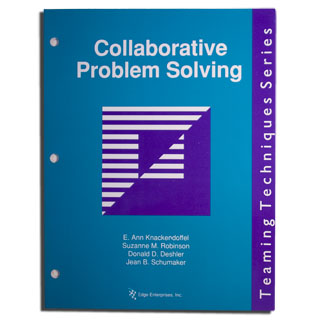
Author(s): E. Ann Knackendoffel, Suzanne M. Robinson, Donald D. Deshler, and Jean B. Schumaker
Publication Info: Edge Enterprises, 1992
The key to solving shared problems relies, in large measure, in the communication skills of the people associated with those problems. Although designed specifically for use in educational settings, Collaborative Problem Solving outlines the communication skills needed to solve problems within any group. These skills include listening actively, reflecting another person’s statements back to that person, asking questions, and summarizing. The skills are then incorporated within a problem-solving process that can be used to structure meetings between two or more people, especially those working together to support specific students. Numerous examples of this process are presented throughout the book, as are opportunities to practice the skills.This process is appropriate for any educator, parent, or person interested in improving communication while working with others to help students succeed. It is especially useful for teachers in cooperative teaching relationships and in collaborative relationships between general and special educators.
Teacher or Student Feedback on Collaborative Problem Solving
Co-Author Ann Knackendoffel says, "The response from teachers in the field has been very supportive. They have been much more visionary than I was when I first created Collaborative Problem Solving and found a multitude of uses for the model beyond just their collaboration with general and special education teachers. They have found the process helpful with working one-on-one with colleagues, but they have been most enthusiastic about how it helps when they have multiple participants in a meeting such as a student improvement or IEP meeting. Teachers have also reported it useful when they are meeting with parents or working with students. They find the Problem-Solving Worksheet keeps them on task and focused on the problem rather than straying off into areas that detract from solution finding."
